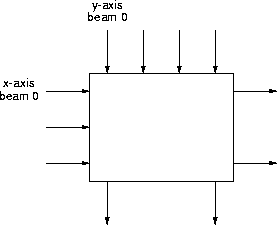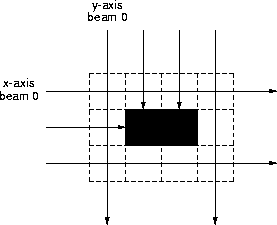The x-axis (horizontal) beams enter the object from the left and scan from top to bottom; the y-axis (vertical) beams enter the object from the top and scan from left to right. The beams enter the object with a positive energy x and leave the object with either the same energy x or zero energy.
An object's insides consists of two kinds of material, one absorbs no energy and the other absorbs all energy.
The procedure's prototype is
void generate_image( const int x_energy[], // The output energy of the x-axis beams. int x_size; // The number of values in x_energy. const int y_energy[], // The output energy of the y-axis beams. int y_size // The number of values in y_energy. int image[25][25] // The generated image. );
x_energy[i] contains the output energy for x-axis beam i, 0 <=
i
< x_size; y_energy[i] contains the output energy for y-axis beam
i, 0 <= i < y_size. The output-energy value is either 0 or some
positive integer.
The generated image is an x_size-by-y_size matrix stored in
image with the image's upper-left element at image[0][0]. The value
at image[x][y] for 0 <= x < x_size and 0 <= y <
y_size is either 0 if the data indicates the object has non-abosrbing
material at that location or 1 if the data indicates the object has absorbing
material at that location. The values in the elements of image outside
the object are ignored and can have any values.
As an example, the picture above would create the following input data for
generate_image():
x_energy[] = { 1, 0, 1 }
x_size = 3
y_energy[] = { 1, 0, 0, 1 }
y_size = 4
generate_image() will store the following data in
image:
image[][] = {
{ 0, 0, 0, 0, /* whatever */ },
{ 0, 1, 1, 0, /* whatever */ },
{ 0, 0, 0, 0, /* whatever */ },
/* whatever */
}
